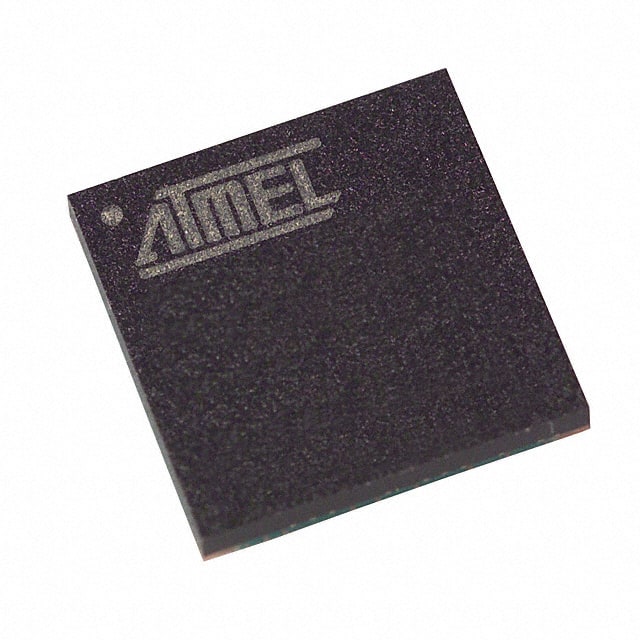AT89C51CC03U-7CTIM
Product Overview
Category
AT89C51CC03U-7CTIM belongs to the category of microcontrollers.
Use
This microcontroller is commonly used in various electronic devices and embedded systems for controlling and processing data.
Characteristics
- High-performance 8-bit microcontroller
- Low-power consumption
- Wide operating voltage range
- Integrated flash memory for program storage
- Multiple I/O ports for interfacing with external devices
- On-chip timers and counters for precise timing operations
Package
AT89C51CC03U-7CTIM is available in a compact and durable package, suitable for surface mount technology (SMT) applications.
Essence
The essence of this microcontroller lies in its ability to provide efficient control and processing capabilities in a wide range of electronic applications.
Packaging/Quantity
AT89C51CC03U-7CTIM is typically packaged in reels or trays, containing a specific quantity of microcontrollers per package. The exact quantity may vary depending on the manufacturer's specifications.
Specifications
- Architecture: 8-bit
- CPU Speed: Up to 40 MHz
- Program Memory Size: 64 KB
- RAM Size: 2 KB
- Operating Voltage Range: 2.7V to 5.5V
- Number of I/O Pins: 32
- Timers/Counters: 3
- Serial Communication Interfaces: UART, SPI, I2C
Detailed Pin Configuration
- VCC - Power supply voltage
- GND - Ground reference
- P0.0 - General-purpose I/O pin
- P0.1 - General-purpose I/O pin
- P0.2 - General-purpose I/O pin
- P0.3 - General-purpose I/O pin
- P0.4 - General-purpose I/O pin
- P0.5 - General-purpose I/O pin
- P0.6 - General-purpose I/O pin
- P0.7 - General-purpose I/O pin
- RST - Reset pin
- P1.0 - General-purpose I/O pin
- P1.1 - General-purpose I/O pin
- P1.2 - General-purpose I/O pin
- P1.3 - General-purpose I/O pin
- P1.4 - General-purpose I/O pin
- P1.5 - General-purpose I/O pin
- P1.6 - General-purpose I/O pin
- P1.7 - General-purpose I/O pin
- XTAL1 - Crystal oscillator input
- XTAL2 - Crystal oscillator output
- P2.0 - General-purpose I/O pin
- P2.1 - General-purpose I/O pin
- P2.2 - General-purpose I/O pin
- P2.3 - General-purpose I/O pin
- P2.4 - General-purpose I/O pin
- P2.5 - General-purpose I/O pin
- P2.6 - General-purpose I/O pin
- P2.7 - General-purpose I/O pin
- ALE/PROG - Address Latch Enable/Program pulse input
- PSEN - Program Store Enable
- EA/VPP - External Access Enable/Voltage Programming Pin
Functional Features
- High-speed processing capabilities
- Flexible I/O configurations for interfacing with external devices
- On-chip memory for program storage and data manipulation
- Timers and counters for precise timing operations
- Serial communication interfaces for data exchange with other devices
- Low-power consumption for energy-efficient operation
Advantages and Disadvantages
Advantages
- High-performance microcontroller suitable for a wide range of applications
- Integrated flash memory eliminates the need for external program storage
- Multiple I/O pins provide flexibility in interfacing with external devices
- Low-power consumption extends battery life in portable devices
Disadvantages
- Limited RAM size may restrict complex data processing capabilities
- 8-bit architecture may not be sufficient for certain advanced applications requiring higher precision or larger data handling capacity
Working Principles
AT89C51CC03U-7CTIM operates based on the principles of digital logic and microcontroller architecture. It executes instructions stored in its internal flash memory, processes data using its CPU, and interacts with external devices through its I/O ports. The microcontroller's working principle involves fetching instructions, decoding them, executing the required operations, and updating the output accordingly.
Detailed Application Field Plans
AT89C51CC03U-7CTIM finds applications in various fields, including but not limited to: 1. Industrial automation systems 2. Home appliances control 3. Automotive
Senaraikan 10 soalan dan jawapan biasa yang berkaitan dengan aplikasi AT89C51CC03U-7CTIM dalam penyelesaian teknikal
Sure! Here are 10 common questions and answers related to the application of AT89C51CC03U-7CTIM in technical solutions:
Q: What is AT89C51CC03U-7CTIM? A: AT89C51CC03U-7CTIM is a microcontroller from the 8051 family, specifically designed for embedded applications.
Q: What are the key features of AT89C51CC03U-7CTIM? A: Some key features include 8-bit CPU, 64KB Flash memory, 2KB RAM, multiple timers/counters, UART, SPI, I2C interfaces, and low power consumption.
Q: How can I program AT89C51CC03U-7CTIM? A: You can program AT89C51CC03U-7CTIM using various programming languages like C or assembly language, using an appropriate development environment and a compatible programmer.
Q: Can AT89C51CC03U-7CTIM be used in industrial automation applications? A: Yes, AT89C51CC03U-7CTIM is suitable for industrial automation applications due to its robustness, reliability, and support for various communication protocols.
Q: Does AT89C51CC03U-7CTIM support real-time operating systems (RTOS)? A: Yes, AT89C51CC03U-7CTIM can be used with RTOS like FreeRTOS, allowing you to build complex multitasking applications.
Q: Can I interface AT89C51CC03U-7CTIM with external devices? A: Yes, AT89C51CC03U-7CTIM provides multiple I/O pins, UART, SPI, and I2C interfaces, allowing you to interface with various external devices such as sensors, displays, and actuators.
Q: What is the maximum clock frequency supported by AT89C51CC03U-7CTIM? A: AT89C51CC03U-7CTIM can operate at a maximum clock frequency of 40 MHz.
Q: Is AT89C51CC03U-7CTIM suitable for low-power applications? A: Yes, AT89C51CC03U-7CTIM offers power-saving features like idle mode, power-down mode, and wake-up from external interrupts, making it suitable for low-power applications.
Q: Can I use AT89C51CC03U-7CTIM in automotive applications? A: Yes, AT89C51CC03U-7CTIM is designed to meet automotive industry requirements, making it suitable for automotive applications like engine control units, dashboard systems, etc.
Q: Are there any development boards available for AT89C51CC03U-7CTIM? A: Yes, there are development boards available that provide easy prototyping and testing capabilities for AT89C51CC03U-7CTIM, enabling faster development of technical solutions.
Please note that these answers are general and may vary depending on specific application requirements and implementation details.


